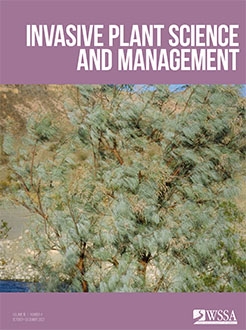Brazilian peppertree (Schinus terebinthifolia Raddi) is an aggressive shrub that infests more than 280,000 ha in Florida. Individual plant treatments (IPT), including basal bark and cut stump application with triclopyr butoxyethylester and triethylamine formulations, respectively, have been used for decades. While they are both effective, resprouting can occur, which requires retreatment for control. Recent research on other woody invasive plants has indicated additional non-crop herbicides used in natural areas can be effective with these IPT techniques and therefore warrant testing on S. terebinthifolia. In 2018 and 2019, basal bark and cut stump studies were conducted at Cape Canaveral Air Force Station in natural areas infested with S. terebinthifolia. In the basal bark application studies, we found aminocyclopyrachlor applied at 12 and 24 g L–1 and triclopyr acid applied at 34 and 69 g L–1 each provided 100% defoliation of multistemmed S. terebinthifolia individuals with a mean root collar diameter up to 20.2 cm at 360 d after treatment (DAT). These were not different from triclopyr ester applied at 96 g L–1. Imazamox applied at 30 g L–1 resulted in 86% defoliation at 360 DAT. However, we observed formulation incompatibility when imazamox was mixed with basal bark oil which may limit its utility. In cut stump studies, we found aminocyclopyrachlor and aminopyralid each individually applied at 6, 12, and 24 g L–1, resulted in stump mortality that was not different from the commercial standard triclopyr amine applied at 180 g L–1. Similar results were found for a triclopyr acid formulation applied at 86 and 172 g L–1 and imazamox applied at 60 g L–1. For both treatment techniques, we found that alternative treatments provided control at lower herbicide concentrations than triclopyr ester and amine commercial standards. These results advance our understanding of IPT and expand access to additional effective herbicide options for S. terebinthifolia management.
BioOne.org will be down briefly for maintenance on 17 December 2024 between 18:00-22:00 Pacific Time US. We apologize for any inconvenience.
How to translate text using browser tools
23 November 2023
Novel basal bark and cut stump herbicide treatments for Brazilian peppertree (Schinus terebinthifolia) management
Mackenzie E. Bell,
Stephen F. Enloe,
James K. Leary,
Dwight K. Lauer
ACCESS THE FULL ARTICLE
<
Previous Article
|
hack and squirt
Individual plant treatment
invasive plant control






